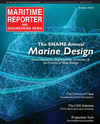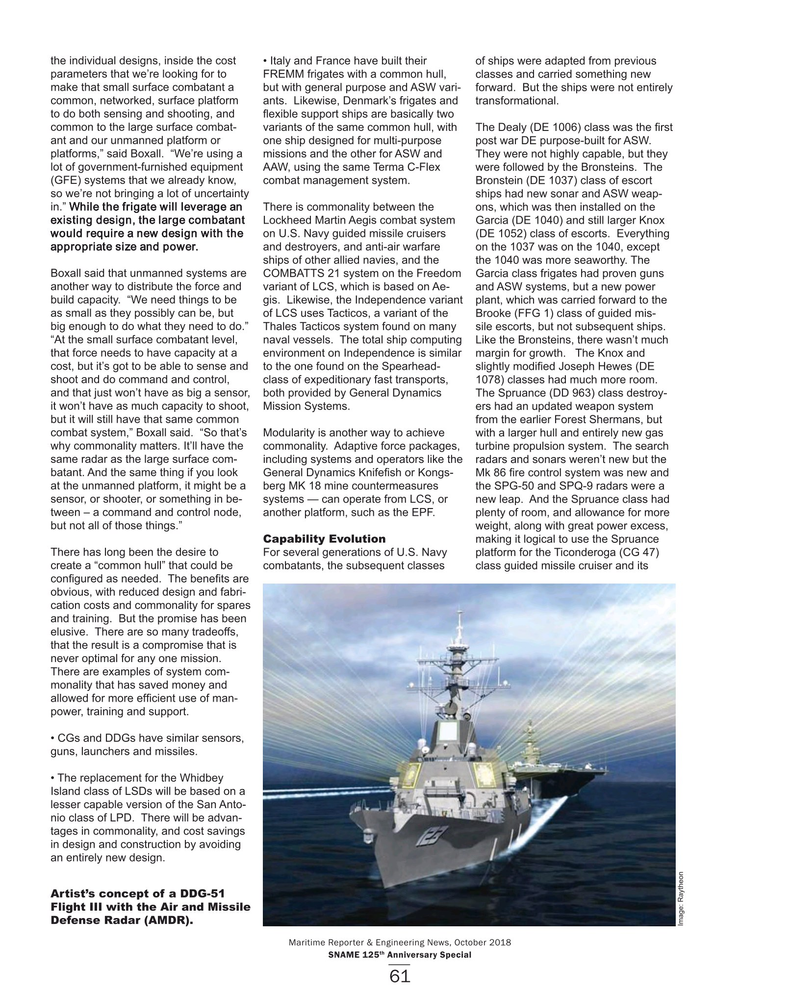
Page 61: of Maritime Reporter Magazine (October 2018)
Marine Design Annual
Read this page in Pdf, Flash or Html5 edition of October 2018 Maritime Reporter Magazine
the individual designs, inside the cost • Italy and France have built their of ships were adapted from previous parameters that we’re looking for to FREMM frigates with a common hull, classes and carried something new make that small surface combatant a but with general purpose and ASW vari- forward. But the ships were not entirely common, networked, surface platform ants. Likewise, Denmark’s frigates and transformational.
to do both sensing and shooting, and ? exible support ships are basically two common to the large surface combat- variants of the same common hull, with The Dealy (DE 1006) class was the ? rst ant and our unmanned platform or one ship designed for multi-purpose post war DE purpose-built for ASW. platforms,” said Boxall. “We’re using a missions and the other for ASW and They were not highly capable, but they lot of government-furnished equipment AAW, using the same Terma C-Flex were followed by the Bronsteins. The (GFE) systems that we already know, combat management system. Bronstein (DE 1037) class of escort so we’re not bringing a lot of uncertainty ships had new sonar and ASW weap- in.” While the frigate will leverage an There is commonality between the ons, which was then installed on the existing design, the large combatant Lockheed Martin Aegis combat system Garcia (DE 1040) and still larger Knox would require a new design with the on U.S. Navy guided missile cruisers (DE 1052) class of escorts. Everything appropriate size and power. and destroyers, and anti-air warfare on the 1037 was on the 1040, except ships of other allied navies, and the the 1040 was more seaworthy. The
Boxall said that unmanned systems are COMBATTS 21 system on the Freedom Garcia class frigates had proven guns another way to distribute the force and variant of LCS, which is based on Ae- and ASW systems, but a new power build capacity. “We need things to be gis. Likewise, the Independence variant plant, which was carried forward to the as small as they possibly can be, but of LCS uses Tacticos, a variant of the Brooke (FFG 1) class of guided mis- big enough to do what they need to do.” Thales Tacticos system found on many sile escorts, but not subsequent ships. “At the small surface combatant level, naval vessels. The total ship computing Like the Bronsteins, there wasn’t much that force needs to have capacity at a environment on Independence is similar margin for growth. The Knox and cost, but it’s got to be able to sense and to the one found on the Spearhead- slightly modi? ed Joseph Hewes (DE shoot and do command and control, class of expeditionary fast transports, 1078) classes had much more room. and that just won’t have as big a sensor, both provided by General Dynamics The Spruance (DD 963) class destroy- it won’t have as much capacity to shoot, Mission Systems. ers had an updated weapon system but it will still have that same common from the earlier Forest Shermans, but combat system,” Boxall said. “So that’s Modularity is another way to achieve with a larger hull and entirely new gas why commonality matters. It’ll have the commonality. Adaptive force packages, turbine propulsion system. The search same radar as the large surface com- including systems and operators like the radars and sonars weren’t new but the batant. And the same thing if you look General Dynamics Knife? sh or Kongs- Mk 86 ? re control system was new and at the unmanned platform, it might be a berg MK 18 mine countermeasures the SPG-50 and SPQ-9 radars were a sensor, or shooter, or something in be- systems — can operate from LCS, or new leap. And the Spruance class had tween – a command and control node, another platform, such as the EPF. plenty of room, and allowance for more but not all of those things.” weight, along with great power excess,
Capability Evolution making it logical to use the Spruance
There has long been the desire to For several generations of U.S. Navy platform for the Ticonderoga (CG 47) create a “common hull” that could be combatants, the subsequent classes class guided missile cruiser and its con? gured as needed. The bene? ts are obvious, with reduced design and fabri- cation costs and commonality for spares and training. But the promise has been elusive. There are so many tradeoffs, that the result is a compromise that is never optimal for any one mission.
There are examples of system com- monality that has saved money and allowed for more ef? cient use of man- power, training and support. • CGs and DDGs have similar sensors, guns, launchers and missiles.
• The replacement for the Whidbey
Island class of LSDs will be based on a lesser capable version of the San Anto- nio class of LPD. There will be advan- tages in commonality, and cost savings in design and construction by avoiding an entirely new design.
Artist’s concept of a DDG-51
Flight III with the Air and Missile
Defense Radar (AMDR).
Image: Raytheon
Maritime Reporter & Engineering News, October 2018 th
SNAME 125 Anniversary Special 61
MR #10 (58-65).indd 61 MR #10 (58-65).indd 61 10/5/2018 10:57:14 AM10/5/2018 10:57:14 AM

 60
60

 62
62
